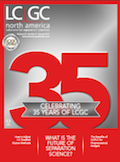A Glimpse into the Rapidly Evolving and Expanding Field of Separation Science
Special Issues
Jared L. Anderson

The complexity of analytes and their accompanying matrices creates considerable challenges for today’s separation scientists, particularly for the analysis of biological samples. Nevertheless, the field continues to match these challenges with new advancements that I believe will continue to mature over the next decade. The separation and analysis of complex samples should involve a suitable sample preparation method that is capable of eliminating matrix components which are detrimental for downstream chromatographic or electrophoretic separations and mass spectrometry (MS) analysis. It is my observation that the importance of sample preparation is often either overlooked or downplayed with greater attention being focused on the chromatographic separation or MS analysis. Part of the reason for this lack of recognition may be due to the fact that many sample preparation approaches used today are confined to kits that can be readily purchased and used without perhaps a complete understanding by the scientist as to how the approach works.
Looking ahead in the field of separation science, I believe there will continue to be major advancements in automation that will drive the coupling of sample preparation to chromatographic platforms. Automation is particularly important in laboratories that require a reliable and customizable route toward high-throughput analysis. Sample preparation methods that require the separation of analytes from complex components within the matrix will be important in areas ranging from biological to environmental and food analysis. Sample preparation methods suitable for both gas chromatography (GC) and high performance liquid chromatography (HPLC) will continue to be developed, with new and novel platforms becoming popular. The miniaturization of sample preparation techniques using selective sorbents or solvents will ensure high enrichment factors while drastically minimizing costs, particularly in disposal.
I believe that the field is poised to see tremendous advancements in the use of three-dimensional (3D) printing to develop customizable substrates for chromatographic separations. Brett Paull and co-workers at the Australian Centre for Research on Separation Science have recently reported fascinating results where polymer thin layer chromatography platforms were printed and used for the separation of dyes and proteins (1). In yet another report from this year, Gertrud Morlock and co-workers at Justus Liebig University in Germany demonstrated the printing of thin silica gel layers for use in planar chromatography (2). These are among the growing number of reports in which 3D printing has been shown as a viable approach to customize a 3D separation platform but to also do so through the combination of numerous printing materials that are on the market today. Now I fully understand that there may be some skeptics out there that may question the overall scope of platforms and applications that separation scientists could fulfill with 3D printed separation devices. However, did you know that 3D printing is already making its way into the food industry and is expected to revolutionize the way in which food products are prepared and produced in the future? The dropping costs of 3D printing technologies make this area rich for exploration in separation science. I believe that advancements in material science will not only allow us to easily modify the substrate that accommodates the chromatographic bed, but will also enable us to have fine control over the ordering of the 3D printed stationary phase. This will permit separation scientists to produce highly customizable separation media. Although a number of technical challenges including the need for fine resolution of printing and the time required to print at such resolution still remain, 3D printing in separation science is an area that I predict will see tremendous growth over the next decade. These innovations will also transform the field of sample preparation. Just this year, Leandro Hantao and co-workers from several institutions in Brazil reported the production of 3D printed microfluidic systems that incorporated on chip solid-phase extraction for the sample preparation of petroleum before GC separation (3). Imagine being able to quickly 3D print a column, precolumn, or sample preparation cartridge with customized stationary phases and sorbents within your own lab! I look forward to seeing separation scientists, engineers, material scientists, and computer scientists all working together to make these advancements a reality!
References
- N.P. Macdonald, S.A. Currivan, L. Tedone, and B. Paull, Anal. Chem. 89(4), 2457−2463 (2017).
- D. Fichou and G.E. Morlock, Anal. Chem.89(3), 2116−2122 (2017).
- E.M. Kataoka, R.C. Murer, J.M. Santos, R.M. Carvalho, M.N. Eberlin, F. Augusto, R.J. Poppi, A.L. Gobbi, and L.W. Hantao, Anal. Chem.89(6), 3460−3467 (2017).
Jared L. Anderson is a professor of analytical and bioanalytical chemistry with the Department of Chemistry at Iowa State University in Ames, Iowa.

Common Challenges in Nitrosamine Analysis: An LCGC International Peer Exchange
April 15th 2025A recent roundtable discussion featuring Aloka Srinivasan of Raaha, Mayank Bhanti of the United States Pharmacopeia (USP), and Amber Burch of Purisys discussed the challenges surrounding nitrosamine analysis in pharmaceuticals.
Extracting Estrogenic Hormones Using Rotating Disk and Modified Clays
April 14th 2025University of Caldas and University of Chile researchers extracted estrogenic hormones from wastewater samples using rotating disk sorption extraction. After extraction, the concentrated analytes were measured using liquid chromatography coupled with photodiode array detection (HPLC-PDA).




















